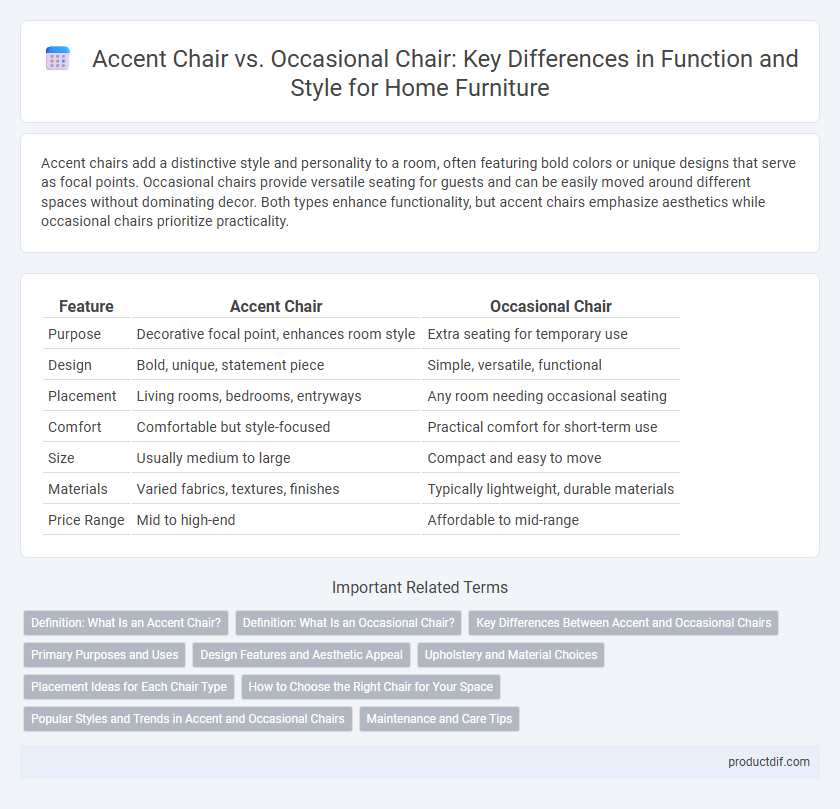Accent chairs add a distinctive style and personality to a room, often featuring bold colors or unique designs that serve as focal points. Occasional chairs provide versatile seating for guests and can be easily moved around different spaces without dominating decor. Both types enhance functionality, but accent chairs emphasize aesthetics while occasional chairs prioritize practicality.
Table of Comparison
| Feature | Accent Chair | Occasional Chair |
|---|---|---|
| Purpose | Decorative focal point, enhances room style | Extra seating for temporary use |
| Design | Bold, unique, statement piece | Simple, versatile, functional |
| Placement | Living rooms, bedrooms, entryways | Any room needing occasional seating |
| Comfort | Comfortable but style-focused | Practical comfort for short-term use |
| Size | Usually medium to large | Compact and easy to move |
| Materials | Varied fabrics, textures, finishes | Typically lightweight, durable materials |
| Price Range | Mid to high-end | Affordable to mid-range |
Definition: What Is an Accent Chair?
An accent chair is a stylish, standalone piece of furniture designed to complement the room's decor while providing additional seating. Unlike functional occasional chairs, accent chairs emphasize aesthetic appeal with unique colors, patterns, or shapes that enhance the interior design scheme. This chair type often features bold fabric or distinct design elements, making it both a focal point and a versatile seating option in living spaces.
Definition: What Is an Occasional Chair?
An occasional chair is a versatile piece of furniture designed primarily for extra seating, often used temporarily in living rooms, bedrooms, or offices. Unlike accent chairs, which emphasize style and decorative appeal, occasional chairs prioritize functionality and comfort for short-term use. These chairs are typically lightweight, easy to move, and come in various designs to complement different interior styles without dominating the space.
Key Differences Between Accent and Occasional Chairs
Accent chairs are designed primarily to enhance the aesthetic appeal and add a pop of color or texture to a room, often featuring bold designs and unique shapes. Occasional chairs prioritize functionality and flexibility, serving as extra seating options that can be easily moved and used when needed. Key differences include intent of use--accent chairs emphasize style while occasional chairs focus on practicality--and typical placement, with accent chairs acting as statement pieces and occasional chairs fulfilling temporary seating needs.
Primary Purposes and Uses
Accent chairs serve as visually striking pieces designed to enhance room aesthetics while providing comfortable seating, often used to complement or contrast existing furniture styles. Occasional chairs focus on practical, flexible seating solutions intended for temporary use during gatherings or extra guest accommodations, emphasizing portability and space efficiency. Both chair types contribute to interior design by balancing function and style, with accent chairs prioritizing decorative impact and occasional chairs prioritizing convenience.
Design Features and Aesthetic Appeal
Accent chairs feature bold colors, unique patterns, and distinctive shapes designed to draw attention and complement the main furniture in a room. Occasional chairs prioritize versatility and subtle elegance with simpler designs that blend seamlessly into various decor styles while offering functional seating. Both chair types enhance aesthetic appeal, but accent chairs serve as focal points, whereas occasional chairs provide understated support.
Upholstery and Material Choices
Accent chairs often feature bold upholstery options like velvet, leather, or patterned fabrics designed to stand out, while occasional chairs prioritize versatility with neutral or classic materials such as linen or cotton blends. The construction of accent chairs typically includes durable hardwood frames and high-density foam cushions for both aesthetics and comfort. Occasional chairs may use lighter materials and simpler upholstery to easily fit into various room settings without overpowering the existing decor.
Placement Ideas for Each Chair Type
Accent chairs are perfect for filling empty corners or creating a cozy reading nook next to a window or fireplace, enhancing both style and function in living rooms or bedrooms. Occasional chairs work well as flexible extra seating around dining tables or in entryways, where they can be moved easily to accommodate guests. Placing accent chairs near focal points adds visual interest, while situating occasional chairs in multipurpose spaces emphasizes convenience and adaptability.
How to Choose the Right Chair for Your Space
When selecting between an accent chair and an occasional chair, consider the primary function: accent chairs serve as stylish focal points with bold designs and colors, enhancing decor, while occasional chairs prioritize flexibility and extra seating without dominating the room. Assess your space size, existing furniture style, and seating needs to determine which chair complements your layout and usage. Optimal placement and material choices ensure the chair not only fits spatially but also harmonizes with the room's aesthetic and comfort requirements.
Popular Styles and Trends in Accent and Occasional Chairs
Popular styles of accent chairs include mid-century modern with clean lines, tufted velvet for a touch of luxury, and wingback designs that blend classic appeal with comfort. Occasional chairs often feature versatile, lightweight frames like bentwood or slipper styles, making them easy to move and ideal for supplementary seating. Current trends emphasize bold colors, mixed materials such as leather and metal, and customizable upholstery patterns to suit diverse interior aesthetics.
Maintenance and Care Tips
Accent chairs require regular dusting and vacuuming to maintain their upholstery, especially in fabrics like velvet or linen that can trap dirt and oils. Occasional chairs, often used less frequently, benefit from periodic cleaning to prevent dust buildup and fabric deterioration, with leather versions needing conditioning to avoid cracking. Both types should be kept away from direct sunlight and moisture to preserve color vibrancy and structural integrity.
Accent Chair vs Occasional Chair Infographic

 productdif.com
productdif.com